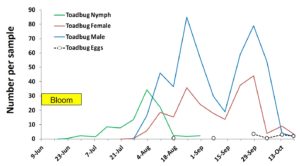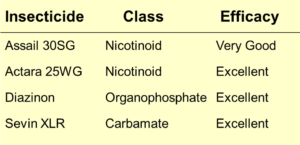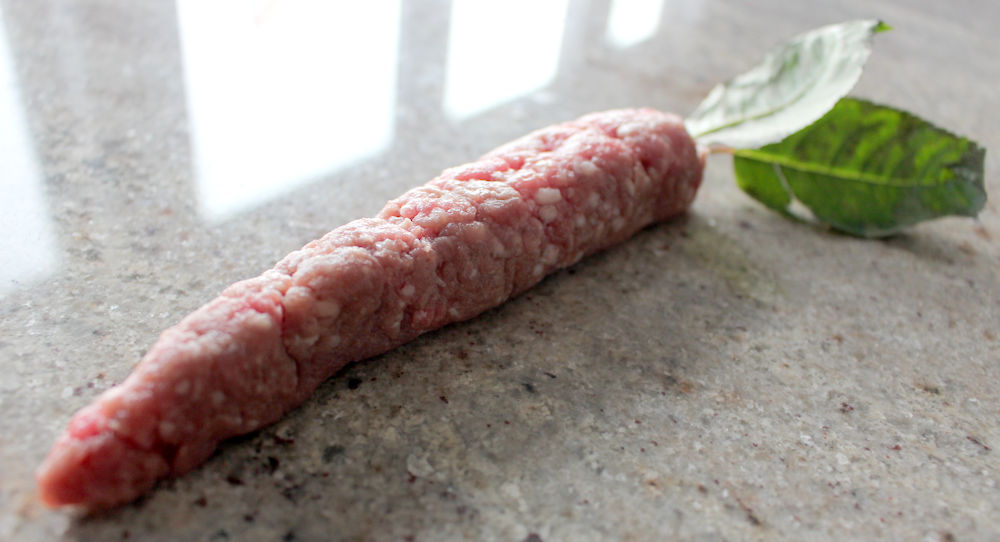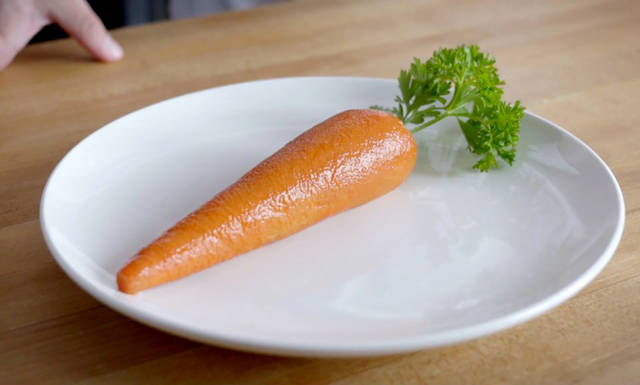- Cucurbit downy mildew has been reported on butternut squash in Gloucester County this week. All cucurbit growers are encouraged to scout their fields on a regular basis and to initiate a downy mildew specific fungicide program. This is the first report of CDM in butternut squash in New Jersey this growing season. To track the progress of CDM in the US please visit the CDMpipe forecasting website here.
- There have been no reports of late blight in the region to date. Phytophthora nicotianae has been reported in the region in recent weeks. Symptoms caused by P. nicotianae look similar to late blight. If you suspect late blight on potato or tomato please contact your county Extension office.
- Basil downy mildew has been reported in southern New Jersey on BDM susceptible sweet basil lines. All basil growers are encouraged to initiate a BDM specific fungicide program. To track the progress of BDM in the US please visit here.
- Black leg symptoms have been reported on potato vines. Growers should dig up a few hills with aerial black leg symptoms to see if bacteria has worked its way into developing tubers. If tubers “stink” then traditional black leg is present. If rotten tubers are present and have no smell, please contact your County agent so samples can be collected and tested.
- Bacterial leaf spot has been reported in tomato and pepper.
- Phytophthora blight has been reported in pepper and other crops.
- Angular leaf spot has been reported on cucurbit crops. Click here for a nice review of diagnosing angular leaf spot, bacterial leaf blight, downy mildew, and anthracnose in cucurbit crops from Dr. Beth Gugino, vegetable pathologist, at Penn State.
- Cucurbit powdery mildew has been reported. Apply and rotate fungicides that are specific for CPM control.
- The 2019 Fungicide Resistance Management Guide for Vegetable Crops in the mid-Atlantic Region is now available for FREE online.
- For more information on controlling these and other important diseases please see the 2019 Mid-Atlantic Commercial Vegetable Production Guide. The guide is available for FREE online by following the links on the Plant and Pest Advisory website. Hardcopies of the 2019 guide can be purchased through your local county Extension office.
Archives for July 2019
Vegetable Disease Update – 7/17/19
Hackettstown Livestock Auction Results for July 16, 2019
This auction sells: lambs, sheep, goats, calves, beef cattle, pigs, rabbits, and all types of heavy fowl. Auctions are held every Tuesday with the first sale beginning at 10:30 am and ending at the last sale 5:30 pm. Hay, straw, grain, and firewood are also for sale.
Farm Fresh Eggs available for purchase by the case (30 doz.) or by the flat (2&1/2 doz.) in the main office Tuesday, Wednesday & Thursday. Also available some Monday’s and Friday’s but please call office first (908)-852-0444.
Click on link for July 16 sale results:
Summer Aeration/Cultivation/Venting
Aeration during the summer can be a helpful practice but does need some caution. Many turf managers performing mid-season aeration on putting greens will be using needle tines, which are less disruptive. But the key words are “less disruptive”; as reminder, needle time aeration (venting) will cause some damage to the roots. How extensive the […]
Managing Cranberry Toad Bug
Toad bugs, Phylloscelis atra, are an occasional pest of cranberries in New Jersey that can cause economic injury. This insect feeds only on

Fig. 1. Seasonal number of toad bug nymphs and adults per sweep net sample
cranberries and has a single generation per year. It overwinters as eggs. The nymphs appear by the end of June through early September, and the adults from end of July through October (harvest) (see Figure 1). Eggs are laid from end of August through October.
Damage. Feeding damage can be noticed in two stages. First stage feeding damage on vines causes closing in (towards the branch) of the leaves on the new growth. Second stage feeding causes changed in color (reddish to brown) of new growth. The damage can be seen from July until harvest. This damage will cause dying of the branch and the berries to shrivel up. Heavy infestation will result in dwarfed berries.
Management. To determine infestation, lightly sweep problematic beds (bugs should be easy to catch in sweep nets as they are very active). Because this is a new pest there is no threshold established yet. Thus, insecticide applications should be based on the relative number of bugs per sweep compared with other sites and previous history of infestation. Currently, growers can use the following control options: Sevin 4F (broad-spectrum carbamate), Diazinon (broad-spectrum organophosphate), or Actara or Assail 30SG (neonicotinoid insecticides, effective against piercing-sucking insects) (see Figure 2). If infestation is high, treatments should be applied when the nymphs are present (i.e., mid- to late-July; see Figure 1).

Fig. 2. Chemical control options for toad bugs
For more information, please see “The Cranberry Toad-Bug” by F.A. Sirrine and B.B. Fulton. 1914. New York Agricultural Experiment Station. Bulletin No. 377. Department of Agriculture, Geneva, NY.
Fruit IPM for 7/10/19
Peach:
Oriental Fruit Moth: During the previous week we were between the 2nd and 3rd OFM flights on most farms, and just starting the third flight this week. Populations on most farms are low, but the timing in southern counties is now if trap captures exceed 6 moths per trap. See timings in the table below: [Read more…]
Meat-Based Carrot

If you spend much time at the meat or dairy counter in your local supermarket, you will find some items that are not actually meat or milk-based. I am not taking a stand for or against those, just to say that for truth in advertising, when I think of meat I think of cows, pigs, and chickens. And when I think of milk, I think of a dairy cow. The link below is a tongue-in-cheek article about “real” meat: Introducing the Meat-Based Carrot
However, this idea of a meat-based vegetable is already being practiced by Arby’s:
Arby’s unveils carrot made of meat: The Marrot
We all know that Arby’s has the meats. Now they have the “megetables.” Click on: Marrot

Arby’s new food category, “meat vegetables,” has its pilot offering: The Marrot.
It looks and tastes like a carrot, but it’s made from turkey.
“Plant-based meats are the latest incarnation of making vegetables look like what Americans really want, which is great, tasty meat,” Jim Taylor, Arby’s chief marketing officer, said on the company’s Inspire Brands website. “Universally, people know we’re supposed to eat vegetables every day. But 90% of Americans don’t eat the recommended amount. So, we said if others can make meat out of vegetables, why can’t we make vegetables out of meat?”
To the end, Taylor called on Neville Craw, the company’s vice president of Culinary Innovation. Neville took a whole turkey breast and trimmed it and rolled it into the shape of a carrot and put it into a plastic pouch and cooked it in a water bath for an hour. Then, he rolled the food in a carrot marinade and brûlée with maple syrup powder. Then, he oven roasted it for another hour. Add a sprig of parsley, and the Marrot is complete.
Wanna see?
Arby’s says The Marrot has more than 70% of the recommended daily value of Vitamin A, with more than 30 grams of protein.
“We’ve never created anything like this,” Neville said. “But most of the product development Arby’s works on is new to the industry. That’s the exciting part of this job; we’re always innovating and hungry for more knowledge.”
Insider got a hold of a Marrot for a taste test, and reports it is “shockingly reminiscent of a carrot in both taste and appearance. The turkey-based pseudo-vegetable had a sweet maple taste with earthy, herb-filled undertones. The only major difference between the Marrot and a traditional carrot was the crunch of the vegetable. Instead, Arby’s megetable had a crisp, glazed coating with the tender interior of a well-prepared turkey breast.”
The product is still in the early stages, and the Marrot sadly won’t be available to hungry customers right away.
However, Craw told Insider he feels “pretty good” that the Marrot and other megetables have a good shot at showing up at Arby’s franchises.
“No promises,” Craw said. “But it’s starting to look like it could be heading in that direction.”
Chris Pastrick is a Tribune-Review digital producer. The Tribune-Review coves Allegheny, Westmoreland, Armstrong and Butler counties in Southwestern Pennsylvania. You can contact Chris at 412-320-7898, cpastrick@tribweb.com or via Twitter .

